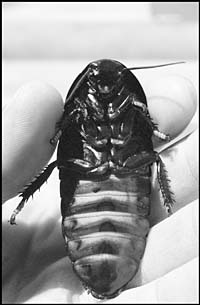Rumors, not roaches, fly, until SPH sets record straight
Some Boston residents awoke last Thursday to warnings that a particularly vicious African insect had invaded their neighborhoods. Fliers affixed to utility polls and slipped under windshield wipers announced an “Infestation Warning” and featured a large picture of an unsavory-looking bug. And before School of Public Health entomologist Richard Pollack could settle down to work in his lab, his phone began to ring with calls from people wanting to know what this was all about.
“I think I’ve got my finger on the pulse of what’s going on, and I hadn’t heard anything about it,” said Pollack, an instructor in immunology and infectious diseases in the award-winning Laboratory of Public Health Entomology. “I thought maybe it was about an Asian longhorn beetle that has been spreading around these parts, but that bug is dangerous only if you are a maple tree.”
Pollack searched his library as well as the Internet for clues and found a Website further describing the supposed invader. Called “Phylomenescus cerberus,” the bug was claimed to have traversed international shipping lanes and was now threatening Boston residents with its paralyzing bite and preference to nest in the stomachs of live hosts.

“I immediately recognized that the beast resembled to an amazing extent the Madagascan hissing cockroach, whose Latin name is Gromphadorina portentosa, and not Phylomenescus cerberus,” said Pollack. In fact, no insects go by that name. Phyllon is the Latin name of a plant; Cerberus is a three-headed dog that guards the gates of Hades in Greek mythology.
“I figured that someone either had too much time on his or her hands and was having some fun at the expense of a few people,” said Pollack, “or there was some other diabolical activity here.”
The Website said that the warning had been issued by the “FIA” under the Infestation Act. Users could plug in their zip codes to find out when the bugs would arrive in their areas, as if the six-legged creatures were following an itinerary.
Pollack e-mailed a discussion group of entomology experts. “Does anyone know the person responsible for this nonsense and this Website?” he asked.
He and some others quickly pieced together the truth behind the warning. They searched for the registrant of the site and found not an agency but a cable television network. The network had created the site to advertise a made-for-TV movie about killer cockroaches, although nowhere on the site is the network or the movie mentioned. The flyers were promotional gimmicks. The FIA does not exist. Nor does the Infestation Act.
A spokesman for the network said the flyers had also been distributed in Chicago, New York, Los Angeles, Philadelphia, Washington, D.C., Seattle, Tampa, and Miami.
“I think the take-home message is don’t believe everything you read, particularly if it’s on the Web or on your windshield,” said Pollack. “Wait for confirmation from a responsible agency one that you have heard of.”
He said if an infestation were real, governmental agencies such as the U.S. Department of Agriculture would first confirm the problem with experts and then contact the media.
“This is an interesting example of how an urban legend can begin and spread very rapidly,” Pollack reflected.
So will he watch the movie when it broadcasts later this month?
“Nope,” said Pollack. “I don’t have cable.”




